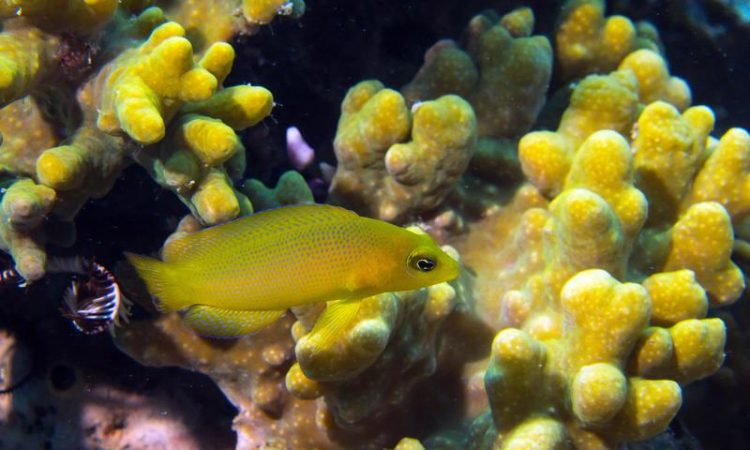Smoke and Mirrors on Coral Reefs: How a Tiny Fish Deceives its Prey

2 A yellow dottyback is well camouflaged within its natural live coral habitat. Christopher E Mirbach
Tropical coral reefs like the Australian Great Barrier Reef are among the most colorful habitats in the world. However, the diversity in color still puzzles scientists: Why exactly do coral reefs host so many colorful organisms such as corals, crustaceans and fish?
The dusky dottyback (Pseudochromis fuscus), a small predatory fish that is found throughout the Indo-Pacific, occurs in many different colorations and has the peculiar ability to be able to change its body coloration. Why dottybacks vary in coloration and why they are able to change their color has long remained a secret.
An international research team led by evolutionary biologists Dr. Fabio Cortesi and Prof. Walter Salzburger from the University of Basel has now been able to explain why dottybacks adopt different colors.
So far, it had been assumed that the color variety is genetically determined, meaning that the different colored dottybacks had likely adapted to their respective habitat background or that coloration was sexually determined.
The zoologists were now able to show that dottybacks can actively change their color in a relatively short amount of time. Their goal: to mimic other fish species in their surroundings in order to prey on their juvenile offspring.
“Wolf in sheep's clothing”
Animals commonly use deception to increase access to food, reproductive opportunities or protection. However, if used too often or out of context, the impostor risks to be busted. The researchers observed that dottybacks used a particularly clever approach to reduce the threat of being found out. These fish change their color to mimic different harmless fish species in their surroundings to prevent being recognized by their prey, the offspring of the mimicked fish.
“This strategy is very similar to the classic example of the wolf in sheep's clothing. However, while the wolf may be found out eventually, dottybacks are able to change their coloration, making it difficult for their prey to learn about the threat they impose”, says first-author Dr. Fabio Cortesi. The study was conducted on the Great Barrier Reef in cooperation with colleagues from Australia, Great Britain, Canada and Sweden.
Researchers train fish
In addition, changing color also provides a second benefit to the dottybacks – it also increases their ability to hide from predators. The researchers trained bigger coral trout to strike at images of dottybacks in front of different backgrounds.
The experiment showed that coral trout struck significantly less often at the dottyback images that were color-matched to the natural background of those fish mimicked by the dottyback. “The dottybacks have developed an intricate form of mimicry that not only gives them a predatory advantage but also protects them from their own predators”, summarizes Cortesi the results.
A part of the riddle about the color richness of tropical coral reefs seems solved. Their inhabitants show an almost inconceivable variety in color and shapes, many of which serve the purpose of a warning signal or to increase protection from predators. Stonefish hide by mimicking their surroundings, sea slugs use vivid colors to warn predators about their distastefulness and cuttlefish are able to change their color in a matter of seconds to either court potential sexual partners or to hide from predators.
Original source
Fabio Cortesi, William E. Feeney, Maud C. O. Ferrari, Peter A. Waldie,
Genevieve A. C. Phillips, Eva C. McClure, Helen N. Sköld, Walter Salzburger, N.
Justin Marshall, and Karen L. Cheney
Phenotypic plasticity confers multiple fitness benefits to a mimic
Current Biology, published online 19 March 2015, doi: 10.1016/j.cub.2015.02.013
Further information
Dr. Fabio Cortesi, Department of Environmental Sciences, University of Basel, phone: +41 (0)78 761 24 41, email: fabio.cortesi@uqconnect.edu.au
https://www.youtube.com/watch?v=UFUQYFdZwlw – Video
http://www.salzburgerlab.org – Research group Prof. Walter Salzburger
http://www.cell.com/current-biology/abstract/S0960-9822%2815%2900151-7 – Abstract
Media Contact
All latest news from the category: Life Sciences and Chemistry
Articles and reports from the Life Sciences and chemistry area deal with applied and basic research into modern biology, chemistry and human medicine.
Valuable information can be found on a range of life sciences fields including bacteriology, biochemistry, bionics, bioinformatics, biophysics, biotechnology, genetics, geobotany, human biology, marine biology, microbiology, molecular biology, cellular biology, zoology, bioinorganic chemistry, microchemistry and environmental chemistry.
Newest articles

A chip unique in the world
A team from UPV and iPRONICS has manufactured the first universal, programmable and multifunctional photonic chip on the market. A team from the Photonics Research Laboratory (PRL)-iTEAM of the Universitat…

Advance in light-based computing
…shows capabilities for future smart cameras. UCLA-developed experimental device demonstrates ability to reduce glare in images. Researchers developing the next generation of computing technology aim to bring some light to…

Evidence for reversible oxygen ion movement during electrical pulsing
…enabler of the emerging ferroelectricity in binary oxides. In a recent study published in Materials Futures, researchers have uncovered a pivotal mechanism driving the emergence of ferroelectricity in binary oxides….





















